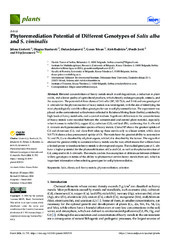Приказ основних података о документу
Phytoremediation Potential of Different Genotypes of Salix alba and S. viminalis
| dc.creator | Urošević, Jelena | |
| dc.creator | Stanković, Dragica | |
| dc.creator | Jokanović, Dušan | |
| dc.creator | Trivan, Goran | |
| dc.creator | Rodzkin, Aleh | |
| dc.creator | Jović, Đorđe | |
| dc.creator | Jovanović, Filip | |
| dc.date.accessioned | 2024-03-11T07:54:30Z | |
| dc.date.available | 2024-03-11T07:54:30Z | |
| dc.date.issued | 2024 | |
| dc.identifier.issn | 2223-7747 | |
| dc.identifier.uri | http://rimsi.imsi.bg.ac.rs/handle/123456789/3183 | |
| dc.description.abstract | Elevated concentrations of heavy metals result in soil degradation, a reduction in plant yields, and a lower quality of agricultural products, which directly endangers people, animals, and the ecosystem. The potential of three clones of Salix alba (347, NS 73/6, and B-44) and one genotype of S. viminalis for the phytoextraction of heavy metals was investigated, with the aim of identifying the most physiologically suitable willow genotypes for use in soil phytoremediation. The experiment was placed on the contaminated soil substrate collected in Kolubara Mining Basin (Serbia), enriched by high loads of heavy metal salts, and a control medium. Significant differences in the concentrations of heavy metals were recorded between the contaminated and control plant material, especially when it comes to nickel (Ni), copper (Cu), cadmium (Cd), and lead (Pb), confirming that S. alba and S. viminalis are hyperaccumulator species of heavy metals. Clone 347 shows the greatest uptake of Cd and chromium (Cr), and clone B-44 takes up these metals only to a lesser extent, while clone NS 73/6 shows a less pronounced uptake of Cr. The roots have the greatest ability to accumulate Ni and Pb, Cu is absorbed by all plant organs, while Cd is absorbed by the leaves. The organ that showed the greatest ability to accumulate heavy metals was the root, which means that willows have a limited power to translocate heavy metals to above-ground organs. The studied genotypes of S. alba have a higher potential for the phytostabilization of Cu and Cd, as well as the phytoextraction of Cd, compared with S. viminalis. The results confirm the assumption of differences between different willow genotypes in terms of the ability to phytoextract certain heavy metals from soil, which is important information when selecting genotypes for soil phytoremediation. | sr |
| dc.language.iso | en | sr |
| dc.publisher | MDPI | sr |
| dc.relation | info:eu-repo/grantAgreement/ScienceFundRS/Zeleni/5357/RS// | sr |
| dc.rights | openAccess | sr |
| dc.rights.uri | https://creativecommons.org/licenses/by/4.0/ | |
| dc.source | Plants | sr |
| dc.subject | Salix / clones / soil / heavy metals / phytoremediation / selection | sr |
| dc.title | Phytoremediation Potential of Different Genotypes of Salix alba and S. viminalis | sr |
| dc.type | article | sr |
| dc.rights.license | BY | sr |
| dc.citation.issue | 5 | |
| dc.citation.spage | 735 | |
| dc.citation.volume | 13 | |
| dc.identifier.doi | 10.3390/plants13050735 | |
| dc.identifier.fulltext | http://rimsi.imsi.bg.ac.rs/bitstream/id/8459/plants-13-00735.pdf | |
| dc.type.version | publishedVersion | sr |

